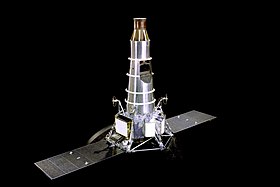Ranger 9

Ranger 9
|
|
| Mission type | Lunar impactor |
|---|---|
| Operator | NASA |
| COSPAR ID | 1965-023A |
| SATCAT № | 1294 |
| Mission duration | 2 days, 16 hours, 31 minutes |
| Spacecraft properties | |
| Manufacturer | Jet Propulsion Laboratory |
| Launch mass | 367 kg (809 lb) |
| Start of mission | |
| Launch date | 21 March 1965, 21:37:00 UTC |
| Rocket | Atlas LV-3 Agena-B |
| Launch site | Cape Canaveral LC-12 |
| Lunar impactor | |
| Impact date | 24 March 1965, 14:08:19.994 UTC |
| Impact site | 12°50′S 2°22′W / 12.83°S 2.37°W |
Ranger 9 was a Lunar probe, launched in 1965 by NASA. It was designed to achieve a lunar impact trajectory and to transmit high-resolution photographs of the lunar surface during the final minutes of flight up to impact. The spacecraft carried six television vidicon cameras - two wide-angle (channel F, cameras A and B) and four narrow-angle (channel P) - to accomplish these objectives. The cameras were arranged in two separate chains, or channels, each self-contained with separate power supplies, timers, and transmitters so as to afford the greatest reliability and probability of obtaining high-quality television pictures. These images were broadcast live on television to millions of viewers across the United States. No other experiments were carried on the spacecraft.
Rangers 6, 7, 8, and 9 were the so-called Block 3 versions of the Ranger spacecraft. The spacecraft consisted of a hexagonal aluminium frame base 1.5 m across on which was mounted the propulsion and power units, topped by a truncated conical tower which held the TV cameras. Two solar panel wings, each 739 mm wide by 1537 mm long, extended from opposite edges of the base with a full span of 4.6 m, and a pointable high-gain dish antenna was hinge mounted at one of the corners of the base away from the solar panels. A cylindrical quasiomnidirectional antenna was seated on top of the conical tower. The overall height of the spacecraft was 3.6 m.
Propulsion for the mid-course trajectory correction was provided by a 224-N thrust monopropellant hydrazine engine with four jet-vane vector control. Orientation and attitude control about three axes was enabled by 12 nitrogen gas jets coupled to a system of three gyros, four primary Sun sensors, two secondary Sun sensors, and an Earth sensor. Power was supplied by 9792 Si solar cells contained in the two solar panels, giving a total array area of 2.3 square meters and producing 200 W. Two 1,200 watt-hour batteries rated at 26.5 V with a capacity for 9 hours of operation provided power to each of the separate communication/TV camera chains. Two 1,000 watt-hour batteries stored power for spacecraft operations.
...
Wikipedia
